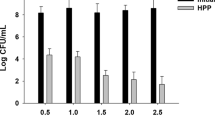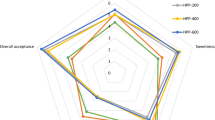Abstract
Jabuticaba (Myrciaria jaboticaba) is a dark-colored fruit native to Brazil that has a desirable flavor and high anthocyanin content. In the present study, jabuticaba juice was produced by steam-extraction and the phenolic compound profile, antioxidant capacity, instrumental color, and microbiological quality were evaluated during 90 days of storage at 25 °C. Cyanidin-3-O-glucoside represented 45% of the total phenolic content of the juice, which reduced with extent of 80% during storage. Total phenolic content of the juice increased by 59% during 90 days of storage, which entailed, average 4.4-fold increase in the content of gallic and ellagic acids. FRAP assay was most sensitive for measuring gallic and ellagic acids, while the TEAC assay was the most sensitive for measuring anthocyanins. Although \( a^{*} \) and \( b^{*} \) values of jabuticaba juice decreased and \( \Delta E^{*} \) increased during storage. Jabuticaba juice remained microbiologically stable during storage, and did not support the growth of inoculated Escherichia coli and Salmonella enteritidis, suggesting antimicrobial activity.

Similar content being viewed by others
References
Amodio ML, Derossi A, Colelli G (2014) Modeling phenolic content during storage of cut fruit and vegetables: a consecutive reaction mechanism. J Food Eng 140:1–8. doi:10.1016/j.jfoodeng.2014.04.006
Association of Official Analytical Chemists (2000) Official methods of analysis, 17th edn. AOAC International, Gaitherburg
Benzie IF, Strain JJ (1996) The ferric reducing ability of plasma (FRAP) as a measure of “antioxidant power”: the FRAP assay. Anal Biochem 239:70–76. doi:10.1006/abio.1996.0292
Cadena RS, Bolini HMA (2012) Ideal and relative sweetness of high intensity sweeteners in mango nectar. Int J Food Sci Technol 47:991–996. doi:10.1111/j.1365-2621.2011.02932.x
Cardoso JMP, Bolini HMA (2007) Different sweeteners in peach nectar: ideal and equivalent sweetness. Food Res Int 40:1249–1253. doi:10.1016/j.foodres.2007.08.004
Castañeda-Ovando A, Pacheco-Hernández ML, Páez-Hernández ME, Rodríguez JA, Galán-Vidal CA (2009) Chemical studies of anthocyanins: a review. Food Chem 113:859–871. doi:10.1016/j.foodchem.2008.09.001
da Silva AN, da Silva RCSN, Ferreira MAM, Minim VPR, da Costa TMT, Perez R (2013) Performance of hedonic scales in sensory acceptability of strawberry yogurt. Food Qual Prefer 30:9–21. doi:10.1016/j.foodqual.2013.04.001
Diniz DN, Macêdo-Costa MR, Pereira MSV, Pereira JV, Higino JS (2010) In vitro antifungal effect of leaves and bark of Myrciaria cauliflora berg. Extracts upon oral microorganisms. Rev Odontol UNESP 39:151–156
Downes FP, Ito K (2001) Compendium of methods for the microbiological examination of foods, 4th edn. American Public Health Association, Washington, D.C
Hager TJ, Howard LR, Prior RL (2010) Processing and storage effects on the ellagitannin composition of processed blackberry products. J Agric Food Chem 58:11749–11754. doi:10.1021/jf102964b
Häkkinen SH, Kärenlampi SO, Mykkänen HM, Heinonen IM, Törrönen AR (2000) Ellagic acid content in berries: influence of domestic processing and storage. Eur Food Res Technol 212:75–80. doi:10.1007/s002170000184
Hellström J, Mattila P, Karjalainen R (2013) Stability of anthocyanins in berry juices stores at different temperatures. J Food Comp Anal 31:12–19. doi:10.1016/j.jfca.2013.02.010
Inada KOP, Oliveira AA, Revorêdo TB, Martins ABN, Lacerda ECQ, Freire AS, Braz BF, Santelli RE, Torres AG, Perrone D, Monteiro MC (2015) Screening of the chemical composition and ocurring antioxidants in jabuticaba (Myrciaria jaboticaba) and jussara (Euterpe edulis) fruits and their fractions. J Funct Foods 17:422–433. doi:10.1016/j.jff.2015.06.002
Jimenez-Garcia SN, Guevara-Gonzalez RG, Miranda-Lopez R, Feregrino-Perez AA, Torres-Pacheco I, Vazquez-Cruz MA (2013) Functional properties and quality characteristics of bioactive compounds in berries: biochemistry, biotechnology, and genomics. Food Res Int 54:1195–1207. doi:10.1016/j.foodres.2012.11.004
Klimczak I, Małecka M, Szlachta M, Gliszczysńka-Swigło A (2007) Effect of storage on the content of polyphenols, vitamin C and the antioxidant activity of orange juices. J Food Comp Anal 20:313–322. doi:10.1016/j.jfca.2006.02.012
Laaksonen O, Mäkilä L, Tahvonen R, Kallio H, Yang B (2013) Sensory quality and compositional characteristics of blackcurrant juices produced by different processes. Food Chem 138:2421–2429. doi:10.1016/j.foodchem.2012.12.035
Lim J (2011) Hedonic scaling: a review of methods and theory. Food Qual Prefer 22:733–747. doi:10.1016/j.foodqual.2011.05.008
Lima MS, Dutra MCP, Toaldo IM, Corrêa LC, Pereira GE, de Oliveira D, Bordignon-Luiz MT, Ninow JL (2015) Phenolic compounds, organic acids and antioxidant activity of grape juices produced in industrial scale by different processes of maceration. Food Chem 188:384–392. doi:10.1016/j.foodchem.2015.04.014
Lopes MLM, Miguel MAL, Fialho E, Valente-Mesquita VL (2016) Grape juice obtained using steam extraction and other small-scale extraction methods: phenolic content, antioxidant capacity and stability during storage. Int J Food Sci Tech 51:1696–1702. doi:10.1111/ijfs.13144
Lyman BJ, Green BG (1990) Oral astringency: effects of repeated exposure and interactions with sweeteners. Chem Senses 15:151–164. doi:10.1093/chemse/15.2.151
Macedo-Costa MR, Diniz DN, Carvalho CM, Pereira MSV, Pereira JV, Higino JS (2009) Eficácia do extrato de Myrciaria cauliflora (Mart.) O. Berg. (jabuticabeira) sobre bactérias orais. Rev Bras Farmacogn 19:564–571. doi:10.1590/S0102-695X2009000400010
Mäkilä L, Laaksonen O, Alanne A-L, Kortesniemi M, Kallio H, Yang B (2016) Stability of hydroxycinnamic acid derivatives, flavonol glycosides, and anthocyanins in black currant juice. J Agric Food Chem 64:4584–4598. doi:10.1021/acs.jafc.6b01005
Meilgaard MC, Carr BT, Civille GV (2006) Sensory evaluation techniques, 4th edn. CRC Press, Boca Raton
Mohanty S, Cock I (2008) Evaluation of the antibacterial activity and toxicity of Myrciaria caulifloria methanolic leaf and fruit extracts. Internet J Microbiol 7:1–21
Obón JM, Castellar MR, Alacid M, Fernández-López JA (2009) Production of red-purple food colorant from Opuntia stricta fruits by spray drying and its application in food model systems. J Food Eng 90:471–479. doi:10.1016/j.jfoodeng.2008.07.013
Plaza M, Batista ÂG, Cazarin CB, Sandahl M, Turner C, Östman E, Maróstica Júnior MR (2016) Chacterization of antioxidant polyphenols from Myrciaria jaboticaba peel and their effects on glucose metabolism and antioxidant status: a pilot clinical study. Food Chem 211:185–197. doi:10.1016/j.foodchem.2016.04.142
Prior RL, Wu X, Schaich K (2005) Standardized methods for the determination of antioxidant capacity and phenolics in foods and dietary supplements. J Agric Food Chem 53:4290–4302. doi:10.1021/jf0502698
Re R, Pellegrini N, Proteggente A, Pannala A, Yang M, Rice-Evans C (1999) Antioxidant activity applying an improved ABTS radical cation decolorization assay. Free Radic Biol Med 26:1231–1237. doi:10.1016/S0891-5849(98)00315-3
Rein MJ, Heinonen M (2004) Stability and enhancement of berry juice color. J Agric Food Chem 52:3106–3114. doi:10.1021/jf035507i
Reque PM, Steffens RS, Jablonski A, Flôres SH, Rios AO, Jong EV (2014) Cold storage of blueberry (Vaccinium spp.) fruits and juice: anthocyanins stability and antioxidant activity. J Food Comp Anal 33:111–116. doi:10.1016/j.jfca.2013.11.007
Rice-Evans CA, Miller NJ, Paganga G (1996) Structure-antioxidant activity relationships of flavonoids and phenolic acids. Free Radic Biol Med 20:933–956. doi:10.1016/0891-5849(95)02227-9
Silva MC, Souza VB, Thomazini M, Silva ER, Smaniotto T, Carvalho RA, Genovese MI, Favaro-Trindade CS (2014) Use of the jabuticaba (Myrciaria cauliflora) depulping residue to produce a natural pigment powder with functional properties. LWT Food Sci Technol 55:203–209. doi:10.1016/j.lwt.2013.08.026
Sinela A, Rawat N, Mertz C, Achir N, Fulcrand H, Dornier M (2017) Anthocyanins degradation during storage of Hibiscus sabdariffa extract and evolution of its degradation products. Food Chem 214:234–241
Verberic R, Stampar F, Schmitzer V, Cunja V, Zupan A, Koron D, Mikulic-Petkovsek M (2014) Changes in the contents of anthocyanins and other compounds in blackberry fruits due to freezing and long-term frozen storage. J Agric Food Chem 62:6926–6935. doi:10.1021/jf405143w
Vidigal MCTR, Minim VPR, Carvalho NB, Milagres MP, Gonçalves ACA (2011) Effect of a health claim on consumer acceptance of exotic Brazilian fruit juices: Açaí (Euterpe oleracea Mart.), Camu-camu (Myrciaria dubia), Cajá (Spondias lutea L.) and Umbu (Spondias tuberose Arruda). Food Res Int 44:1988–1996. doi:10.1016/j.foodres.2010.11.028
Wang Z, Zhang M, Wu Q (2015) Effects of temperature, pH, and sunlight exposure on the color stability of strawberry juice during processing and storage. LWT Food Sci Technol 60:1174–1178. doi:10.1016/j.lwt.2014.09.015
Wu S-B, Dastmalchi K, Long C, Kennelly EJ (2012) Metabolite profiling of jaboticaba (Myrciaria cauliflora) and other dark-colored fruit juices. J Agric Food Chem 60:7513–7525. doi:10.1021/jf301888y
Zafrilla P, Ferreres F, Tomás-Barberán FA (2001) Effect of processing and storage on the antioxidant ellagic acid derivatives and flavonoids of red raspberry (Rubus idaeus) jams. J Agric Food Chem 49:3651–3655. doi:10.1021/jf010192x
Funding
The authors gratefully thank Conselho Nacional de Desenvolvimento Científico e Tecnológico (CNPq), Universidade Federal do Rio de Janeiro (UFRJ), Coordenação de Aperfeiçoamento de Pessoal de Nível Superior (CAPES), and Fundação Carlos Chagas Filho de Amparo à Pesquisa do Estado do Rio de Janeiro (FAPERJ) (Brazil) for financial support.
Author information
Authors and Affiliations
Corresponding author
Rights and permissions
About this article
Cite this article
Inada, K.O.P., Duarte, P.A., Lapa, J. et al. Jabuticaba (Myrciaria jaboticaba) juice obtained by steam-extraction: phenolic compound profile, antioxidant capacity, microbiological stability, and sensory acceptability. J Food Sci Technol 55, 52–61 (2018). https://doi.org/10.1007/s13197-017-2769-3
Revised:
Accepted:
Published:
Issue Date:
DOI: https://doi.org/10.1007/s13197-017-2769-3




